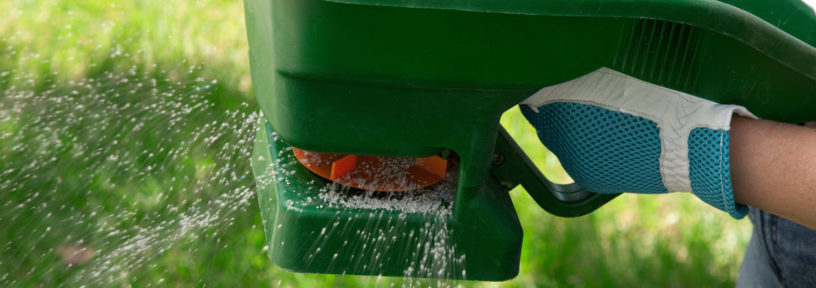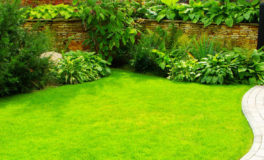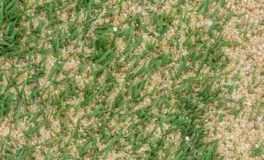After a long summer of getting the best out of your lawn, it is time to start preparing it for autumn and winter. Autumn is the perfect time of year to start again with your lawn treatment and lawn feeding. The soil temperature is still warm enough to stimulate grass growth but it won’t be scorched by the summer sun.
Your lawn works hard and deserves the best of care, especially during autumn and winter. In this article, from guest blogger David Hedges Gower we’re looking at the importance of autumn-winter lawn feeding. We’ll look at how to apply autumn lawn feed and fertilising your lawn in the winter. But first, some things you need to know beforehand:
- Roots continue growing during the winter months
- Well-fed lawns are better able to resist disease and cope with frost
- Always use a lawn feed formulated for autumn-winter use
- Apply between October and February – every 6-8 weeks if the weather permits
We’re rocketing through autumn, and no doubt it won’t be long before the weather people are telling us winter’s coming early! So this is a really important time of year to think about your lawn. How are you going to keep it fertilised in the winter and prepare it for tough times ahead?
How to Apply Autumn Lawn Feed
First you want to rake or scarify your lawn. Regular raking (or scarifying as it is known) keeps levels of thatch at an acceptable level. To remove thatch, rake vigorously but carefully with a spring-tined rake. Autumn is a great time to scarify as you can rake a little deeper than in spring when you would have to be more delicate due to the young growth.
Next, to prepare the soil, aerate your lawn. The process of aerating is essentially spiking the lawn to allow for more air (and nutrients including water) to get to the grass roots. Small areas can be spiked with a garden fork, spacing holes 10-15cm (4-6in) apart and deep. On clay or waterlogged soils, use a hollow-tine aerator every three to four years.
Once the lawn is flat and aerated, it’s time to put some top dressing down. Top dressing is the application of loam, sand and well-rotted organic matter to a lawn in order to correct surface irregularities and fills the holes created by aeration.
Finally, it’s time to add the lawn feed. You should use a different lawn fertiliser in autumn that you would use when you are preparing your garden in spring. Autumn lawn fertiliser is high in potash and phosphates which will better protect the grass from frost and icy conditions.
How to Fertilise Lawn in Winter
UK lawns have to cope with some challenging weather conditions in winter. While it doesn’t require as much maintenance as spring and summer, winter lawns need feed too. The grass blades may not be growing very fast, but they are alive and they are photosynthesising.
Fertilisers come in 2 main forms: quick-release and slow-release. Quick-release Autumn/Winter fertilisers are used for root strength over the winter. A low nitrogen fertiliser with high phosphate and potassium strengthens the roots and stiffens the leaf blades. Slow-release fertilisers are ideal in the late season as they have low nitrogen, high potassium and magnesium. All designed to feed all grassed areas just enough to aid late-season growth.
If Feeding your Lawn in Autumn/Winter Seems Complicated – You’re Not Alone
The world of fertilisers can seem like a minefield – not just the products, but how to use them, when to use them, and whether to use them at all.
But it doesn’t have to be so complicated. The simple fact is that lawn fertilisers all work to some extent. No one would be selling ones that didn’t. But it’s when you start examining the product specifications that things get confusing.
If you’re daunted by the different NPK calculations for different seasons or struggling to integrate these into your rudimentary feeding programme, you’d be forgiven for firing up Google. Maybe for some that’s the best solution – hire the right firm and you’ll have a well-looked-after lawn.
But this article is here to help those of you who still like getting out there yourself. For those of you personally involved in what happens to your garden, this will help you learn about lawn care. It will also help to keep your lawn healthy and fertilized throughout the year. Some are confused by even the timing of the seasons themselves – when exactly does summer end and autumn begin?
Lawncare: When Does Summer End and Autumn Begin?
Unfortunately, no one can answer that accurately – we just have to keep an eye on prevailing conditions that can range from heavy autumnal rains to late dry Indian summers. But one thing you can do is to choose a reliable fertilizer. As said previously, they all work, but some work better than others.
Unreliable weather is one of the many reasons we love the Harrowden Turf range of lawn feed. The Rejuvenator Autumn/Winter grass feed is nicely balanced and will suit your lawn equally whether we’re basking in mild autumn or heading for an early chill. And this gives you more confidence when you’re worried about the other aspects of feeding.
Versatile Lawn Feeds
For example, if you were to follow the sports turf model of lawn care, you’d be obsessed with the shut-off dates for this or that fertilizer. But for most of us with gardens, what should matter is whether we’ve scarified the lawn (which allows more of the fertilizer to reach more of the grass) or how much fertilizer to use (which is almost as important as what sort), instead of worrying too much about the best autumn-winter lawn feed.
The really good news is that a reliable product like Turfonline’s Rejuvenator can sit happily on the lawn without harming it, waiting for some seasonal rain to water it in. So you can be proud of your environmental gardening techniques!
It is not uncommon to give your lawn a pick-me-up in September, or at the start of autumn, to revitalise them after dry summer weather and to ensure they are fit enough to get through winter. A great way to do this is to supply your lawn with a feed. We recommend using an autumn lawn fertiliser, which is high in phosphates and potash. To get the best results, don’t use a spring fertiliser as these tend to have high levels of nitrogen which could result in the leaves being damaged by frost.
Feeding does not have to be overwhelming, but if you want some more advice or haven’t yet devised a simple year-round feeding plan, you can find all of that in my book, Modern Lawn Care.
For now – bon appetite to your lawn!

 Lawn feed tips for your new lawn
Lawn feed tips for your new lawn  Topdress your lawn this Autumn
Topdress your lawn this Autumn 

